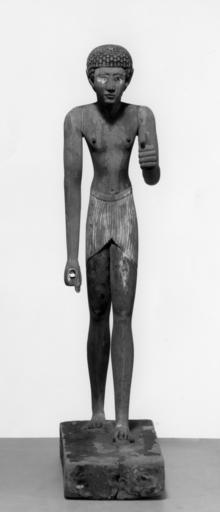MAKE A MEME
View Large Image

| View Original: | Egyptian_-_Male_Figure_Standing_-_Walters_22237.jpg (775x1800) | |||
| Download: | Original | Medium | Small | Thumb |
| Courtesy of: | commons.wikimedia.org | More Like This | ||
| Keywords: Egyptian - Male Figure Standing - Walters 22237.jpg Statues such as these were placed inside the tomb sometimes adjacent to the coffin to provide an additional home for the ka of the deceased individual to reside in This statue represents a man who wears a short pleated shendyt and a short wig made up of rows of rectangles His left leg is advanced his right arm is at his side and his right hand is clenched and pierced His left arm is positioned forward joined at the elbow with his left hand pierced and holding a fragment of a dowel His hair consists of tile-like curls arranged radially leaving his neck and ears uncovered He wears a short vertically pleated shendyt with a belt positioned below his navel According to Steindorff it is possible that a middle piece was originally fastened above and in front by means of wooden nails or pegs The toes are deeply carved and both the toenails and fingernails are carefully worked and articulated The ears are carved the nostrils are drilled the eyes are painted and the nipples are inlaid with small nails The body was painted red to indicate the tanned skin color of a male Despite excellent overall workmanship the piece displays some unusual proportions this statue has a long nose big ears a large upper body and head and a small waist His hair is painted black his eyes black and white his body red his shendyt white and the base stands upon is black The left upper arm the left lower arm the right arm the legs below shendyt and the fronts of both feet were all made separately and attached to the body The pegs in the rectangular base go through the prongs attached to the feet and anchor the statue to it The bottom right edge of the base appears to be missing but it may have been intentionally carved that way as it does appear finished It may have been carved that way to give the pegs access it still has three peg holes and one peg preserved and it may have also served to attach it to another base on its right possibly a larger base in order to form a group statue There are vertical cracks in the statue's right hip and back There are also cracks in the base which has also been repaired a split in the top of the base has been filled in with a plaster-like substance There is overall loss of pigment from the surfaces of the statue and the base between 2347 1793 BC late Old Kingdom-Middle Kingdom wood with black white and red paint H with base cm 40 3 accession number 22 237 25264 Dikran Kelekian New York and Paris date and mode of acquistion unknown as 12th Dynasty Assiout Henry Walters city Baltimore Walters Art Museum Henry Walters Acquired by Henry Walters 1912 place of origin Meir Egypt Walters Art Museum license Ancient Egyptian statues in the Walters Art Museum | ||||